Moving in mono: Cruising to music by any means necessary

I had hoped to write about the sale of my truck this week, but events have not yet played out. So instead I’m going to give you my odd history with automotive sound systems. Note that in 2017 I wrote a five-part series for Hagerty on the history of obsolete automotive audio (here are links to part 1, 2, 3, 4, and 5), but this will be far more personal.
When I was growing up on Long Island in the 1960s, my father had a monophonic hi-fi sound system in the living room with a Heathkit AA13 amp that he’d built (he was an electrical engineer), a Garrard turntable, a Lafayette tuner, and a single AR-4 speaker. While he was alive, it was used mainly to play Broadway soundtracks. The standard ’60s stuff … you know—Fiddler on the Roof, Man of La Mancha, The Fantasticks, Camelot. When I was nine years old, I remember asking him what the bass and the treble knobs did. He explained and twisted them for me to demonstrate, but I couldn’t hear their effect. Of course, the soundtrack of Camelot didn’t exactly have the snap or the frequency range of, say, Paul McCartney’s bass and George Harrison’s sitar on Sgt. Pepper’s Lonely Hearts Club Band, and I have no recollection of rock and roll like that finding its way via the tuner into the house to educate me. Likewise, if there was a radio in my parents’ 1963 Ford Fairlane, I have no recollection of it pumping scratchy music into the Long Island air. To be clear, it wasn’t as if my father clamped down on music in any way. The lack of happenin’ tunes in the Siegel ancestral household to grab me and make me pay attention to audio was just a generational thing.
After my father passed, my mother bought ’69 Plymouth Satellite. My earliest recollection of listening to music in a car is hearing Cousin Brucie on WABC spin songs on the AM radio in the Satellite. Perhaps it was the fact that the Satellite was the first family car with air conditioning, allowing windows-up driving that didn’t drown out the tunes. Whatever the reason, I have sharp clear memories of my sister and I fighting for control of the radio dial and hearing songs as disparate as Neil Young’s “Only Love Can Break Your Heart,” Norman Greenbaum’s “Spirit in the Sky,” and Desmond Dekker’s “Israelites.” Toto, I don’t think we’re in Camelot anymore.
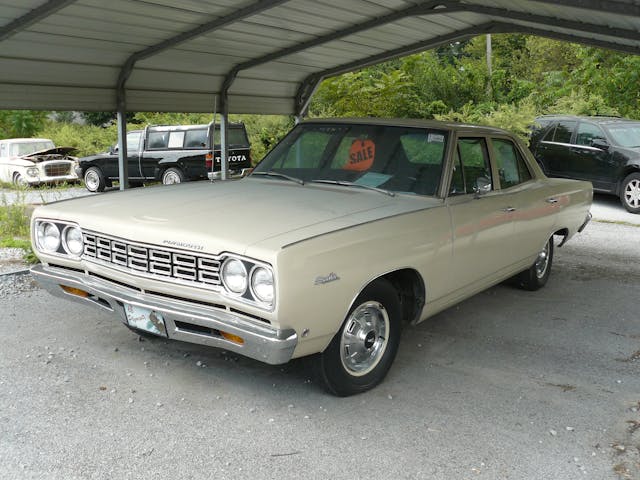
After we moved up to Amherst, Massachusetts, I briefly worked in a stereo store when I was in the 8th grade. In addition to being the place I first saw a Lotus Europa, it’s where I developed an understanding of audio. If someone was interested in a pair of big expensive speakers, the store’s owner would crank Emerson Lake and Palmer’s “Lucky Man.” The combination of the jangly twin acoustic guitars, the crisp snare crack, the woofy electric bass, and the thunderous 36.71 Hz low D synthesizer note at the end of the song literally moved product.
A few years later, when I was in high school, I learned to drive in the Satellite, but when the car’s repair bills mounted, and when the Arab oil embargo hit in 1974 causing gas prices to spike, my mother went shopping for a small car. I, who had been bitten by the BMW 2002 bug as a 13-year-old when a 2002-owning college student lived with us for the summer, begged her to buy one, but they were too pricey, so she bought a brand-new ’74 Fiat 128 two-door instead. It was a stripped car with no radio and no A/C, but it had a four-speed standard transmission. My mother taught me how to drive a stick, and as soon as I got my license, I had fairly free run of the Fiat. In return, I pretended it was a 2002 and beat on it mercilessly.
Having a driver’s license and a car with four-on-the-floor was awesome, but one thing was missing—tunes. I begged my mother to let me install a sound system in the Fiat. I think she gave me a $20 budget. Presaging the Hack Mechanic that I would become, I bought a used monophonic FM radio, hung it from the underside of the dash with furniture brackets and drywall screws, and laid the no-longer-used AR-4 speaker from my father’s sound system on the back seat. The car had no tach, but there was so much ignition interference on the radio that you could estimate engine rpm from the whine. I didn’t care. I was driving a stick with tunes. I was in absolute heaven.

I bought the 1970 Triumph GT6+ the summer of ’76 after I graduated high school. The previous owner had stuffed both an 8-track player and a cassette player into that tiny interior (the cassette in the console, the 8-track hanging down from the left under-dash). When I bought it, the car came with two 8-track tapes. In the glove box was Eagles Greatest Hits, which I think was a legislatively mandated requirement for any car in 1976, along with ridiculously large bumpers and crushing levels of hastily-integrated emission controls. But the album that was already queued up in the 8-track player was Gary Wright’s Dream Weaver. When I drove the car home after the purchase, the song “Love is Alive” began cranking over the car’s decent aftermarket sound system. I’m not sure that any other piece of music roots me so completely to an automotive-specific time and place. When Gary Wright passed away in early September, I went back and listened to “Love is Alive,” and confirmed that a) it’s still a killer song, and b) it still puts my 18-year-old butt right back into the GT6’s seat. The summer of 1978, a few months before I sold the Triumph, The Cars’ debut album broke on the radio, and like Gary Wright, I can’t hear “Just What I Needed” (or anything else off that album) without imagining myself in the car.

Fast-forward to winter 1981. When my then-girlfriend Maire Anne and I were preparing to move down to Austin, Texas (her job running an animal lab at Harvard had been transferred there), outfitting her 1971 VW Bus with tunes for the four-day drive was a necessity. My ex-boss—the guy who’d had the 2002 when I was in junior high school—gifted us a Fosgate Punch 100-watt power amp he’d pulled out of a car before selling it. I, who had no job waiting for me in Austin, spent most of my remaining cash on a Craig “Road-Rated” cassette deck with a pair of RCA output jacks to feed the Punch power amp. For speakers, I continued the fine tradition I’d begun with placing my father’s AR-4 on the Fiat’s back seat and used my two massive ESS AMT9s home stereo speakers. I installed them in the back of the bus (hey, we had to move them anyway, right?) and put a plywood board and a mattress on top of them so one of us could sleep while the other one was driving. When I showed this system to friends, the uniform response was “You’ve got to be kidding me,” only they didn’t say “kidding.” You could’ve faced the speakers backward and used the music as propulsion.
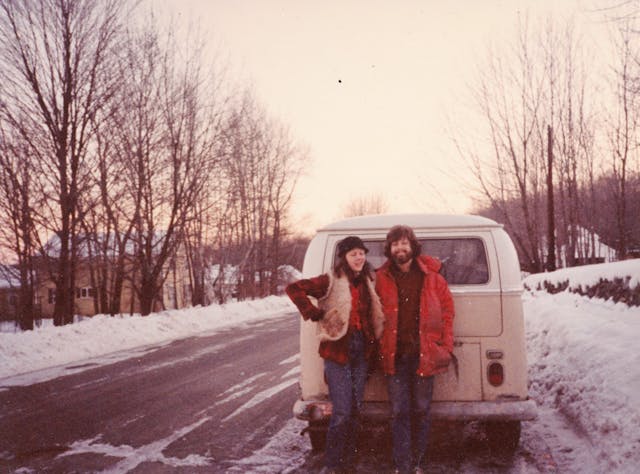
Once we were settled in Austin and I bought my first project BMW 2002, I mounted in it the Craig tape deck, the Fosgate power amp, and a pair of ADS 200s (speakers in little Kleenex-box-sized metal die-cast boxes) that I’d bought at a pawn shop. When I first drove the revived car with its freshly-rebuilt transmission, brand-new Pirelli P3 tires, and killer stereo through the Texas hill country—winding it up, shifting the no-longer-crunching transmission through the gears, cornering on the new rubber, and listening to The Psychedelic Furs’ “The Ghost in You” jumping off a fresh Maxell UDXLII tape—I was the happiest guy on the planet. I honestly don’t think I’ve ever felt that my needs in life were so completely satisfied.
The ADS 200s had two versions—standard home bookshelf speakers and versions that had threaded holes for brackets meant to be mounted on a car’s back deck. These were the bookshelf versions, so there was no obvious mounting method. I found that they wedged nicely on the back deck under the rear windshield and didn’t move around while driving, but they were also highly visible and thus likely to be stolen, so I took a couple of ¼-inch guitar-style plugs and jacks, installed a jack panel on the back deck, wired it to the power amp, and made the speakers un-pluggable so they could be removed and put in the trunk. It was my first of several steps toward non-permanent stereo installations. Of course, as BMW informally stood for “Break My Window” because of both stereo theft as well as theft of the entire car, that’s the way the industry was moving anyway.

When we moved back to Boston, one of the 2002 parts cars I bought had a high-dollar sound system with an Alpine deck, an ADS power amp, and a pair of ADS 300i flush-mount speakers. This system found its way into several cars, including my ’73 E9 3.0CSi, with the Alpine in a slide-mount-removable “Benzi Box.” Although I didn’t mutilate the door panels by cutting holes for speakers, I did cut rectangular holes in the back deck for the 300i speakers and cut a second set of holes in the rear seat’s kick panel for a pair of subwoofers, decisions that are now commonly regarded as an act of cruelty against a vintage car.
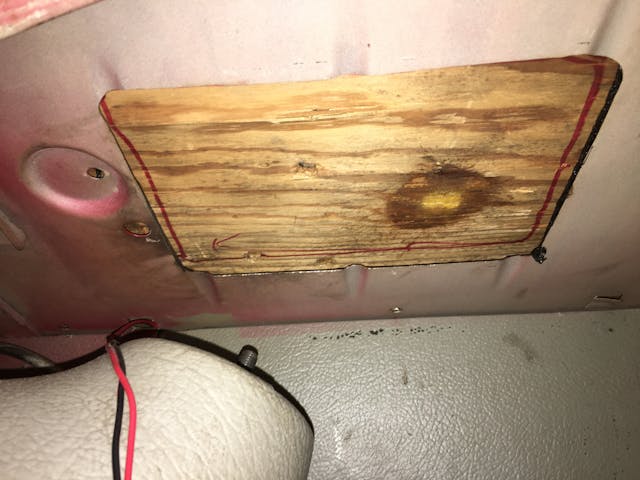
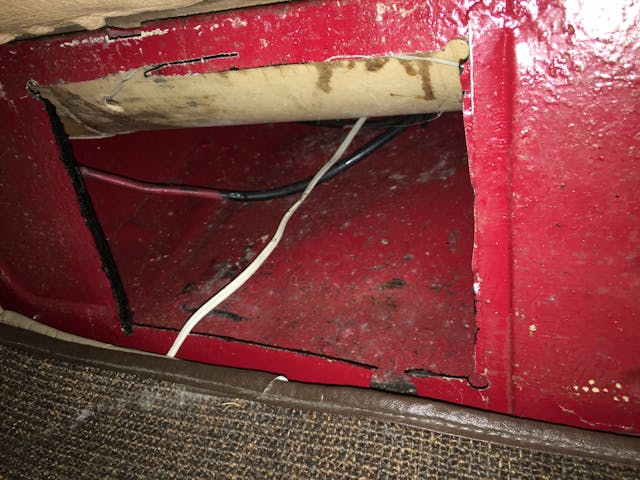
As part of replacing the console when I retrofitted air conditioning into the E9 in 2000, I swapped out the Alpine cassette deck for a Pioneer CD player. Although I specifically tried to find a deck with a very simple design (that is, no Star Trek The Motion Picture graphics), it still clearly looked like it teleported in from the wrong millennium. Surprisingly but perhaps mercifully, I can’t find a single photo of the system in the car, a cosmic indictment of the fact that it wasn’t supposed to be there. I didn’t really use it that much, as there was something about the placement of the ADS 300i speakers in the back deck that set up an unpleasant resonance. It probably could’ve been tuned out with proper equalization, but I wound up removing the 300is and installing them into another car.

As the number of cars multiplied, I moved away from direct installations in favor of portable systems that I could throw in a car before a road trip. Initially I used a Cambridge Soundworks PC Works system with two small satellite speakers and a small, powered subwoofer. As the name implies, it was meant for use with a desktop computer, but its advantages were that a) you could plug in an aux cable from your iPod (and later your phone), b) it sounded surprisingly good, c) the powered subwoofer had a 12-volt jack that you could power directly off the car’s cigarette lighter socket, and d) for the $30 a used system cost you, if it got stolen from the car, who cared?

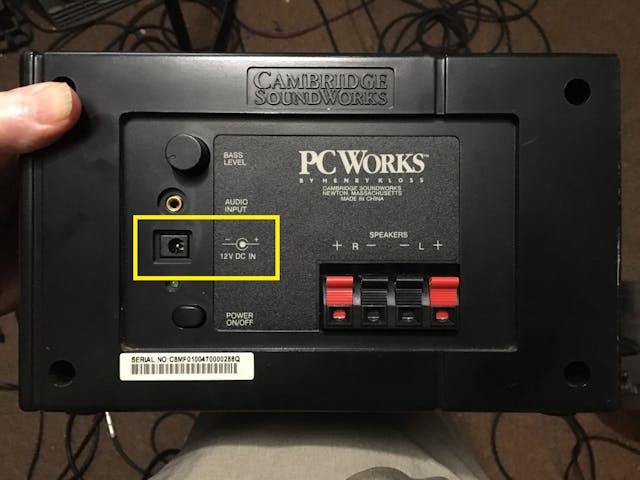
Once I went down the Cambridge Soundworks rabbit hole, I found the then-way-cool but now-laughably-clunky Cambridge Soundworks Model 12 that had a small, old-school stereo amplifier and two removable satellite speakers inside a little road case that also held an integral subwoofer. Like the PC Works system, the Model 12 runs off a cigarette lighter, but it sounds much better. When I found one of these locally for $150, I jumped at it. I used it for a few road trips, jamming the case with the sub behind the driver’s seat, sticking the satellites to the back deck with Velcro and balancing the little amp on the transmission hump. It sounded great, but it wasn’t really a very good solution, as it was a bit too valuable for the “go ahead and steal me” approach of its PC Works brother, and the pack-up and re-deploy time to pull it in and out of the car was non-trivial.
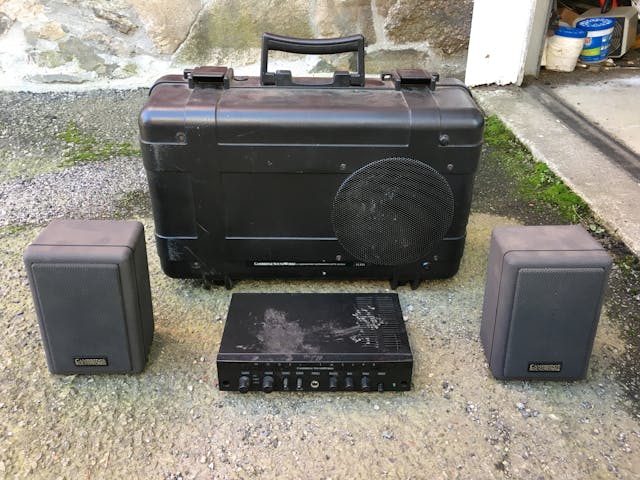
Because the Pioneer CD player in the E9 was too old to have an aux port, for a while when I was annually road-tripping the E9 coupe to The Vintage in Asheville, North Carolina, I resurrected the ADS Power Plate amp that’s still mounted in the trunk, fed it music directly from my phone via an aux-to-RCA adapter, and tried the old Fiat / VW Bus / BMW 2002 approach of pumping the sound into stereo speakers like the ADS 200s. However, over the years I found the high-volume levels needed to overcome the wind noise in the vintage cars fatiguing and began the road-trip in thought-provoking silence instead. The exception is my 2003 E39 530i— compared with the vintage cars, it’s very quiet, and its bone-stock sound system is astonishingly good.
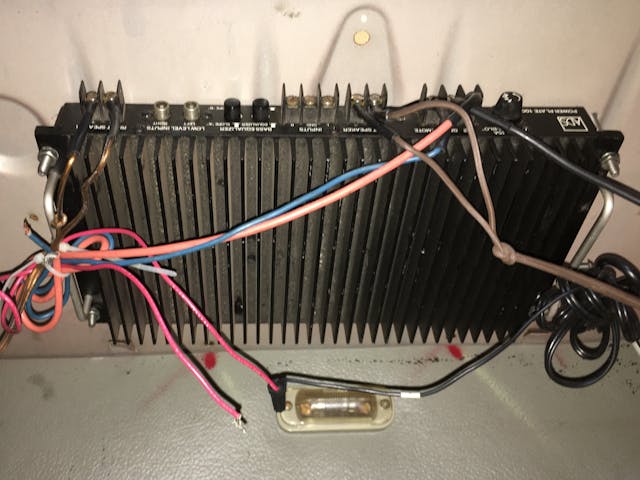
Of course, with vintage cars, what the market values is the original in-dash radio. I’m responsible for the violence committed against my E9 in the name of tunes, but in my defense, two of my BMW 2002s have never had their interiors cut up for a sound system and are still wearing their original functional Blaupunkt mono FM units, and those things will only change over my dead body. I’ll sometimes twiddle the tuner knob just for the novelty of it if I’m at a traffic light running an errand on a Sunday morning. I’m well aware that I could send these units out and have them retrofitted for Bluetooth, but I don’t see the point. It’s doubtful it would make me listen to them more. I have a period-correct mono Blaupunkt for the E9 too. I’ll install it the next time I need to pull apart the console.
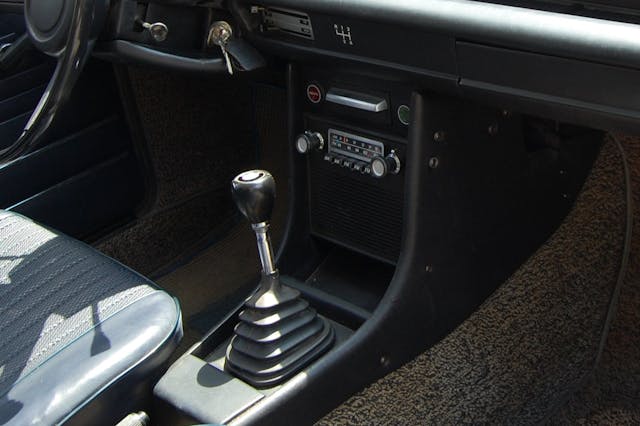
I don’t know if it’s the fact that, at age 65, I’m now officially a get-off-my-lawn senior citizen, but my days of in-car audio seem to have naturally ended. These days, when a car with a big woofing sound system rolls by pumping out oodles of Lucky Man-ending bass, I have a reaction where I feel physically ill.
The more I think about it, the more I realize that if, during one of the short periods I have the monophonic Blaupunkt turned on in one of the 2002s, something from Camelot came on, I’d probably enjoy it. My father would be so pleased.
***
Rob’s latest book, The Best Of The Hack Mechanic™: 35 years of hacks, kluges, and assorted automotive mayhem is available on Amazon here. His other seven books are available here on Amazon, or you can order personally-inscribed copies from Rob’s website, www.robsiegel.com.
Check out the Hagerty Media homepage so you don’t miss a single story, or better yet, bookmark it. To get our best stories delivered right to your inbox, subscribe to our newsletters.


I’ve always had a thing for car audio, too. I really dig that model 12 system. My brother had a brand new ’91 S10 and a friend who worked at a car stereo store. He loaded it with a Sony CD, a bunch of Rockford Fosgate Punch speakers and a Punch 45 amp. The Punch 45 is now in our ’63 Nova powering 2 Infinity 6×9’s and the stock radio is converted by Aurora Designs. It powers the (2) 3 1/2″ Infinity speakers in the dash. Not much of a sound stage, but it’s loud, sounds good, and has Bluetooth. The best part to me is that at a glance it looks stock, just like the rest of the car, but it isn’t.
I had the exact same Cambridge PC sub/satellite system in my ’74 Plymouth Satellite for a while. I used Velcro on the speakers to attach them tot he dash, and it did work surprisingly well. In my ’64 Corvair convertible, I stuffed a 6×9 full range into the center dash speaker location, wired it to a 25W amp in the dash, and plug it into my phone for road tunes- all discreet and reversible, while the factory AM radio lives in its proper spot in the dash. I loved reading your tales; I’ve got stacks of vintage car stereo gear in my shop I need to go through and test.
I’m so glad I’m not the only one who used this solution!
If all of those recitations of system pieces/parts dating back to the dawning of the Age of Aquarius are indeed accurate, I’m duly impressed, Hack. I couldn’t even tell you the brand names, and heaven forbid the model numbers of the sound systems in my current cars, let alone what I installed back in ’68! Coming of musical and automotive age right when rock and roll was transitioning from Elvis to the British Invasion, I was certainly into getting the most out of the old AM/FM in-dash radios of the ’50s and early ’60s. I obviously committed atrocities to any number of door panels and package trays in those days. And I drilled countless holes under dashes when the 4-track and then 8-track players became affordable (in fact, I installed an inoperable Craig/Pioneer 8 player thusly in my current ’66 Pontiac just for period correct “looks” a couple of years ago – today it sports a Deep Purple tape and there is a box of about 60 tapes in the trunk so I can change them out according to my mood…no Camelot, but Andy Williams’ Moon River is back there).
Interesting read!
A great write up of the evolution of car stereo. I recall when every closed, corner gas station had been converted into a pop-up “car stereo sales and installation center”, equipped with sawzalls and drills for that custom mutilation. Being in Tempe, AZ at the right time, I got to meet Jim Fosgate through his Operations Director. They did the final assembly of those amazing amps by hand, in AZ. While Jim was a mad scientist / genius in electronics, he lacked good counsel on the operation of a growing company and some unfriendly bankers pushed them into receivership. An investment group bought the brilliant tech and the rights to Jim’s name, and moved into a building on Rockford Drive in Tempe, thus the current RockfordFosgate. I’m sure I still have a box of original, real Fosgate equipment, with hand etched serial numbers, from multiple installations. Ah, the days of running #8 wire direct from the battery to trunk mounted amps.
This was a different angle for an article and I really enjoyed it.
I started tampering with car audio around the same time I started tampering with cars. At first, it was adding an amplifier inline with the stock head unit and speakers. It doesn’t take too long to figure out why this formula doesn’t work, so I started adding aftermarket speakers and head units. Hiding wires, A-pillar tweeters, the whole nine yards. This peaked out in the mid-2000s when (a) I generally lost interest in dismantling the interior of cars, and (b) the quality level of factory radio systems improved significantly. I currently have two full set-ups from back in the day stored away for a rainy day (head unit upgrades will of course be needed) but I have found that most of my cars either already have adequate sound systems, or there is more than enough sound coming from under the hood
Congratulations on owning a rare item…’70 GT6+s had chrome bumpers. They ended production before giant rubber bumpers came in.
My first car, a 1974 BMW 2002 which I bought used in ’75, came without a radio. It’s important to understand how essential “tunes” were in those days, but my car-anal tendencies made me loath to drill or cut holes into any panel on the interior. So I found a radio that fit into the compartment below the heater controls, wedged it in there with foam, and put a black plastic panel on top of it. It was hideous, but did not penetrate the car’s interior in any way. The speakers sat on the floor in front of the back seat connected to nothing but speaker wire and held in place with more foam. If someone sat in the back seat, I’d just unplug the speakers and toss them in the trunk. I remember taking a lot of ribbing from my butcher-moonroof, kick-panel-speaker buddies for this setup.
I quite like this idea! There is an elegance to making things fit properly by stuffing the space with fill, even if it is a bit unsightly, it has the finesse to be permanent.
In 1977 I was the first in my circle of friends to buy an under the dash Pioneer Super Tuner . All my friends never saw such a car stereo with all the switches and dials as well as the great sound and soon some would buy their own Super Tuner . That unit went from my 65 mustang , 74 Celica GT , and finally my 74 VW Sunbug . Later I would get a Sanyo in dash high power auto- reverse unit for my 75 Sirocco hooked up to 6×9 coaxial speakers proving you didn’t have to spend a lot to get a lot . I bought it from a discount audio store on Route 17 in Paramus NJ that had every model of every brand they carried on display .
These days really loud music makes one of my ears fuzz out and I am content with much lesser units as long as they have a loudness setting , good radio reception , and blutooth connectivity as the internet station Rewound Radio is my main go to these days .
I’m a big audio guy. ADS car stereo stuff that brings back memories. There was so much good stuff back when every car had a din or double din slot in the car. Today selection is slowly drying up.
I’ve had decent results rebuilding tube radios for all my 6 volt cars, this is AM which reaches much farther out, here in central MN we have stations that play old everything, tubes do it best, we enjoy as we drive, don’t need to spend a ton of money to do it.
WarrenE
Great article. Took me back in time to one memorable moment and the value of K.I.S.S. I’d spent all summer installing a “separate component system” in my “Disco” Orange 1976 L-48 Corvette. Inside was a Alphasonic 8” subwoofer/amp, cricket tweeters, Alpine cassette head unit, Kenwood mini graphic equalizer and Alphasonic coaxials. To me, it was something to behold. (Even sounded good.) The month of fussy work was all worth it and life seemed good. Then a friend stopped by to show me his latest buy. A Bad-ass Black, Shaker Hood, 1979 Smokey/Bandit Trans Am. While scoping out the odd honey-comb wheels, the “every where burgundy velour” interior, and the glass t-tops that went forever, I noticed in the back window, two 6×9 boxes housing “Jensen Tri-Axel” speakers. (Yawn-yawn I thought.) I don’t recall what deck he had or the name of the single amp bolted away in the Trans-Am’s trunk, but when he shoved in a Aerosmith cassette and cranked it up, I knew I had brought a knife to a gun fight. Clear, deep and LOUD! And to add salt to my wound, he put this in over the weekend! While it was interesting watching my sub woofer ruffle a piece of paper inside the Vette. It was nothing like seeing that Trans-Am rattle my Corvette’s t-tops. Sometimes KISS rules.
Car audio is a lot like real estate… location location location. Small speakers in the right spot make a lot better sound than big ones pointed at the roof. I also learned that the right speakers and the right crossover eliminate the need for graphic equalizers
I fondly recall myself and most of my friends hanging every type of radio apparatus off the bottom of our dashboards-Craig Powerplay 8 track with pulsating red light, fm converter, CB radio and more. What a hoot with cabinet speakers on the rear shelf blocking out all but a fraction of rear window. Blasting out the new Rush album! The wiring jobs were terrible, but as long as they worked, we were happy!
Ahh, the memories of young adulthood.
I bought some amplified 6×9 “Mindblower” speakers from a stereo shop and had them installed in my ‘76 Audi Fox (Rabbit).
When I arrived to pick up the the now coolest Audi within a 200 yard radius my mind is blown by the new Mindblowers all wired up but resting on the rear seat cushion in the bottom half of their styrofoam shipping box.
When I ask WTF? they tell me the Mindblowers are really tough to wire and there was no room to install them in my German masterpiece. That will be $150 please in 1976 dollars which is about 3 mil today. This is before I learned to say “BS” in a controlled rage kind of way.
I rested them ever so precariously under the rear window on the back deck and never considered wearing a helmet for protection during a hard stop because they sounded great!
Many of us have old, as in prewar, certainly before the late ’50s cars to listen to their own music; the murmur of torque, occasional crescendo of horsepower, to be alone with our thoughts, “enjoy the ride,” music a distraction. The AM radios in a good car of the ’40s, late ’30s, had a rich tone; you’d almost think the announcer was beneath the dash, but music is something we enjoy elsewhere.
Some of us don’t even want music in the garage, it being a sanctuary of stillness, reflection, absorption, all the better not to drop some unique bolt in a blind crevice of the engine bay. A late friend one of whose cars took BOS at 2000’s Bauble Beach said he couldn’t understand “these guys who stand around talking in their garage. I work alone.”
Berry Gordy said they mixed Motown records to sound good on the cheap AM car radios of the ’60s.
It was more than just Motown. I did a fair amount of recording in the mid to late 80s. I can attest to the fact that every studio I went in had three sets of monitors. There were the big expensive ones, the mid-sized ones (usually Yamaha NS10s), and the little ones intended to do exactly what you say—provide an industry standard of crappiness for mixing for the automotive environment.
Recently during a boring overnight shift I tallied up all the cars that have had my name on the registration, if not title… 79. Probably at least half of them with my own installation of a component system. Couldn’t tell you meaningful details about any of them Hack, so props to you for ratholing, mentally and physically, so much info on your past systems! Fun read for sure, I learned another meaning for BMW and never thought about facing speakers out back to aid in propulsion – some of those base boxes move enough air it’d probably at least help, kind of like a real early version of a hybrid!